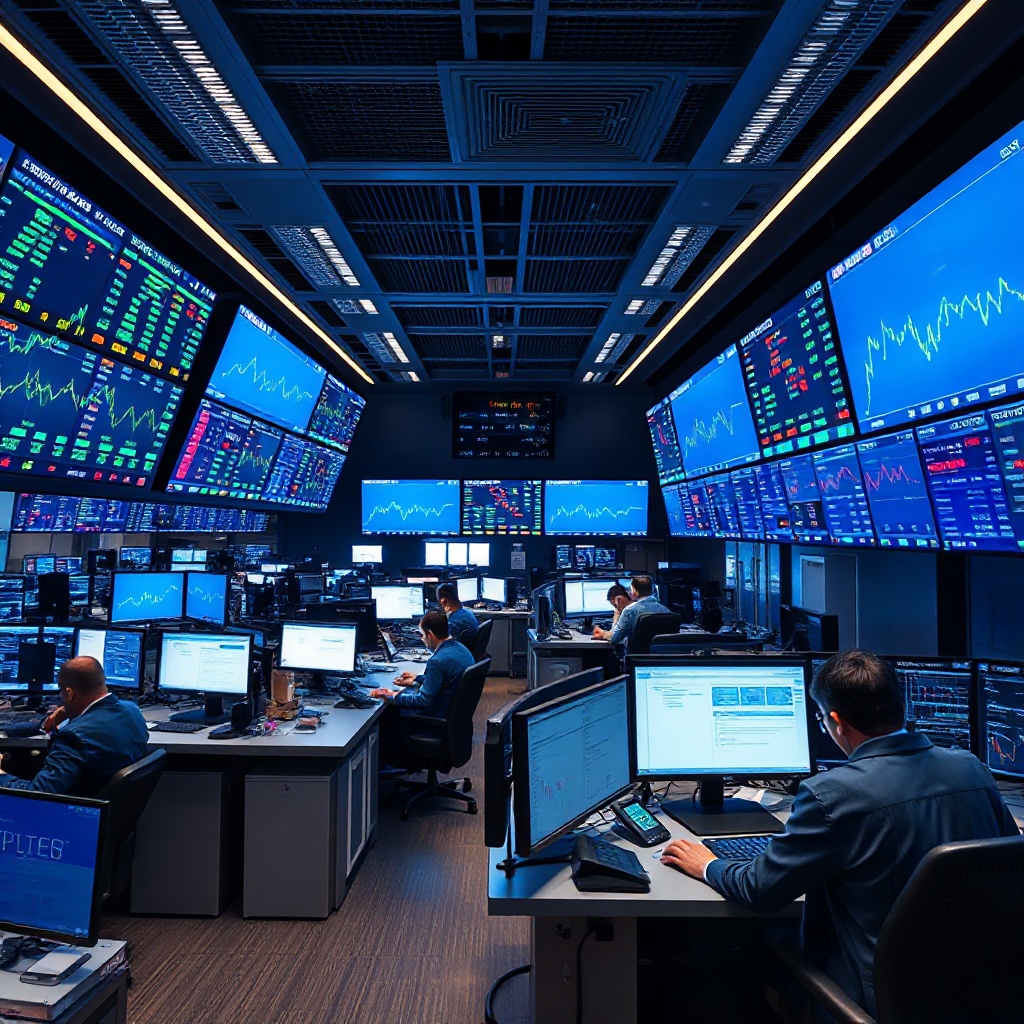
IoT revolutionizes financial trading with real-time market data, predictive analytics, and automated processes, growing at 11.9% CAGR through 2030.

Drivetech Partners
The Internet of Things (IoT) is reshaping financial trading by creating networks of interconnected devices that deliver unprecedented market insights and trading capabilities. The financial sector has quickly adopted this technology, with the IoT in banking and financial services market valued at $57.55 billion in 2023 and projected to grow at a CAGR of 11.9% through 2030.
Key Takeaways
Real-time market intelligence from IoT sensors enables instant responses to market fluctuations and more informed trading decisions
Advanced predictive analytics combine IoT data with machine learning algorithms to forecast market trends with greater accuracy
IoT enhances security protocols through biometric authentication, continuous monitoring, and automated fraud detection
Smart contracts and automated processes triggered by IoT devices reduce operational costs and free traders to focus on strategy
The technology creates opportunities for new business models in financial trading through optimized resource utilization and personalized experiences
The Revolution of IoT in Financial Markets
The Internet of Things represents a network of interconnected physical devices that collect and share data without human intervention. In financial trading, these devices include sensors, cameras, wearables, and other hardware that continuously gather environmental and market data. This information travels via internet connections to cloud platforms where it undergoes processing and analysis.
The basic structure of IoT implementation includes four key components: sensors that gather data, connectivity infrastructure that transmits information, data processing systems that analyze the inputs, and user interfaces that present actionable insights. This technological foundation has transformed how financial institutions approach trading by providing greater visibility into market conditions and enabling faster, more informed decisions.

Real-Time Market Intelligence Through Connected Devices
IoT devices have revolutionized how traders access and process market information. These connected technologies deliver continuous data streams on market conditions, providing immediate feedback on fluctuations, price movements, and economic indicators. This constant flow of information enables traders to maintain close monitoring of relevant markets regardless of their physical location.
The mobility advantage cannot be overstated—traders can now access critical market data from anywhere at any time through connected devices. This capability allows for instant responses to market changes, potentially capturing opportunities that might otherwise be missed. Additionally, IoT sensors embedded in physical assets enable real-time tracking and management of collateral for loans and financing, creating more efficient trading operations.
This technological advancement has transformed traditional market microstructure through enhanced data collection capabilities. The granularity and immediacy of the information gathered through IoT sensors provide traders with a competitive edge in understanding market dynamics and positioning themselves accordingly.

Advanced Predictive Analytics and Strategic Decision Making
The true power of IoT in financial trading emerges when combining collected data with advanced analytical tools. By analyzing the massive datasets gathered through connected devices, traders can identify patterns and predict market trends with increasing accuracy. Machine learning algorithms can process this information to forecast future market movements, giving traders the ability to make proactive rather than reactive decisions.
Real-time analytics significantly enhance the precision of market predictions, allowing traders to minimize risks while maximizing potential profits. The integration of artificial intelligence with IoT creates physical systems that adapt and respond to changing market conditions without constant human intervention.
Financial institutions gain significant competitive advantages through these improved decision-making capabilities. The comprehensive data analysis provides insights that might not be apparent through traditional market research methods, enabling more sophisticated trading strategies and better-informed investment decisions.

Enhanced Security Protocols and Risk Management Strategies
IoT implementation delivers advanced security solutions that protect financial institutions from cyber threats and fraud. Connected cameras and biometric sensors enhance physical security at bank branches and ATMs, while IoT-enabled systems monitor transactions in real-time to detect unusual patterns that may indicate fraudulent activity.
Multi-factor authentication systems integrated with IoT add multiple security layers through biometric authentication and facial recognition. These technologies verify user identities more accurately than traditional password-based systems, reducing the risk of unauthorized access to trading platforms and financial accounts.
The continuous monitoring of branches, ATMs, and data centers through IoT sensors improves the overall security posture of financial institutions. By identifying potential threats before they escalate, these systems enable proactive risk management strategies that can prevent significant losses and maintain customer trust.
Automation and Smart Contract Implementation
One of the most transformative aspects of IoT in financial trading is the ability to trigger automated responses based on predefined conditions. IoT devices can initiate smart contracts automatically when specific criteria are met, reducing the need for manual intervention and accelerating transaction processing.
The automation of repetitive tasks through IoT integration frees traders to focus on strategic initiatives rather than routine operations. Embedded sensors can identify issues such as cash shortages or technical problems, enabling immediate resolutions before they impact trading activities.
Intelligent ATM networks and branches leverage IoT for predictive maintenance and automated cash management, ensuring consistent service availability. Similarly, finance departments can automate core processes through efficient information collection and processing, reducing operational costs and minimizing human error in data handling.
Successful Implementation Case Studies
Numerous financial organizations have already realized significant benefits from IoT integration. For example, a leading energy trader integrated IoT devices and analytics tools into its energy management system, resulting in improved decision-making and increased profitability. By gathering real-time data on energy markets, the company could identify trends earlier and position its trades accordingly.
Another company adopted IoT technologies to gather continuous data on energy consumption and production, enabling better prediction of price fluctuations and more strategic trading approaches. The insights gained from IoT data allowed the company to adjust its trading strategies in response to changing market conditions.
Financial institutions are increasingly using IoT for asset tracking, with sensors monitoring the location and status of assets in real-time. Banks have implemented IoT-enabled biometric authentication for frictionless transactions while offering personalized assistance based on customer preferences and behavior patterns.
Hedge funds and high-frequency trading firms were early adopters of IoT technologies, recognizing the competitive advantage of faster data access. Now these applications are spreading to other areas of the financial sector, including traditional banks, regulatory bodies, and fintech companies.
Overcoming Implementation Challenges
Despite the clear benefits, implementing IoT in financial trading presents several challenges. Data overload is a major concern, requiring companies to prioritize relevant information and use advanced filtering techniques to extract actionable insights from the massive amounts of collected data.
Reliance on outdated technology can hinder the effectiveness of real-time data processing. Financial institutions must invest in modern infrastructure capable of handling the processing demands of IoT data streams to realize the full potential of these technologies.
Best practices for successful implementation include:
Integrating IoT devices with advanced analytics tools for meaningful data interpretation
Investing in scalable processing systems that can grow with increasing data volumes
Providing comprehensive staff training to ensure effective use of IoT-derived insights
Scheduling regular updates and upgrades to maintain optimal system performance
Developing flexible strategies that allow traders to adapt quickly to market changes
Economic Benefits and Future Trajectory
IoT helps finance departments save time and money through efficient data gathering and transfer. The technology reduces transaction costs by cutting search costs, replication costs, tracking costs, and verification costs—all of which contribute to more cost-effective trading operations.
IoT integration streamlines operations, increases productivity, and reduces costs for trading organizations. The economic advantages extend beyond direct cost savings to include improved customer experiences, more targeted service offerings, and new revenue opportunities through data monetization.
Looking ahead, future developments will likely include greater integration with artificial intelligence and distributed ledger technologies. This convergence will further enhance the capabilities of IoT in financial trading, enabling more sophisticated analysis and more secure transaction processing.
As IoT continues to mature, it will support entirely new business models in the financial sector and enable more personalized trading experiences based on comprehensive market intelligence. Financial institutions that embrace these technologies now will position themselves advantageously for the next evolution of trading platforms and services.
Sources:
highradius.com - IoT in Finance
iotloops.com - IoT-Driven Trading: Enhancing Market Intelligence and Decision Making
visionfactory.org - Internet of Things (IoT) and Its Impact on the Financial Industry
grandviewresearch.com - IoT Banking Financial Services Market Report
mktplace.org - Unleashing the Power of IoT in Trading
risingwave.com - Unlocking the Potential of Energy Trading with Real-Time Data





